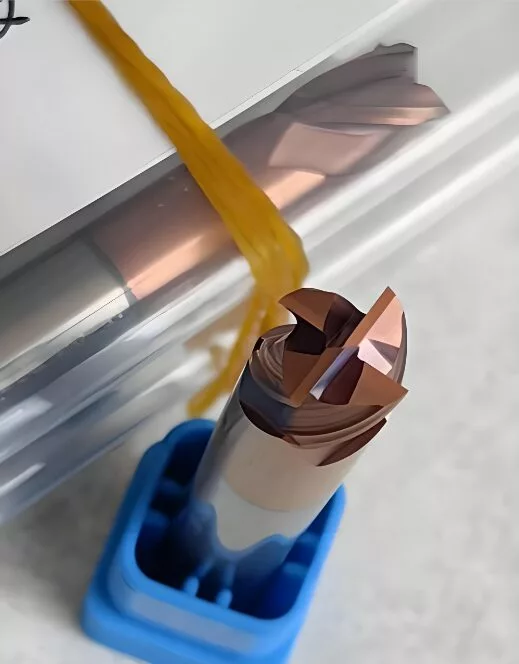I. Core Scenarios for Prioritizing High Hardness
-
When machining high-hardness workpiece materials
When the hardness of the workpiece material is ≥ HRC 45 (e.g., hardened steel, mold steel, bearing steel) or it is a superalloy, wear-resistant cast iron, etc., high-hardness milling cutters should be prioritized. According to industry consensus, the hardness of the cutting tool must be 2-4 times that of the workpiece to achieve effective cutting. In such cases, cemented carbide, polycrystalline cubic boron nitride (PCBN), ceramics, and other materials are preferred. For example, when machining quenched mold steel with HRC 55-65, PCBN tools have a hardness of 8000-9000 HV and a heat resistance temperature of up to 1400°C, with a tool life 8 times longer than ordinary cemented carbide.
-
High-speed cutting and finish machining scenarios
High-speed cutting (cutting speed ≥ 100 m/min) generates a large amount of cutting heat, requiring milling cutters to have excellent high-temperature hardness stability. TiAlN-coated cemented carbide milling cutters can withstand temperatures up to 900°C and achieve high-speed cutting at Vc = 800 m/min in the machining of HT250 gray cast iron. Finish machining has extremely high requirements for dimensional accuracy and surface quality; a cutting edge wear of 0.01 mm may lead to the scrapping of precision parts. High-hardness tools can effectively control wear and ensure machining accuracy within the micron level.
-
Mass production and high-efficiency machining requirements
In mass production, tool change frequency directly affects production efficiency. The wear resistance of high-hardness milling cutters can significantly extend their service life. For example, when machining carbon steel in batches, multi-layer composite coated (TiCN/Al₂O₃/TiN) cemented carbide milling cutters reduce the cost per cutting edge by 35% compared to single-layer coated tools, while increasing machining efficiency by 30%-50%. For products with high consistency requirements such as steam turbine components and aerospace precision structural parts, high-hardness tools can ensure dimensional stability during mass machining.
II. Key Scenarios for Prioritizing High Toughness
-
Interrupted cutting and rough machining conditions
During interrupted cutting, the cutting edge of the milling cutter must repeatedly withstand impact loads from cutting in and out; insufficient toughness can easily lead to chipping. For example, when machining parts with grooves or notches, or cleaning cast surfaces, cemented carbide milling cutters with high cobalt content (6%-10%) or M35 high-speed steel (HSS) milling cutters have a 40% higher chipping resistance than ordinary tools. In the rough machining stage, the depth of cut is large and the cutting load is unstable; high-toughness tools can withstand greater cutting stress and reduce the risk of tool breakage.
-
Machining viscous or impact-prone materials
Materials such as aluminum alloys, stainless steels, and titanium alloys are highly viscous and have chips that are not easily broken. During cutting, built-up edges (BUE) are likely to form and cause impacts on the cutting edge. In such scenarios, high-toughness tools with sharp edge designs should be selected, such as HSS or fine-grain cemented carbide milling cutters with positive rake angles (15°-20°). These tools can not only reduce cutting forces but also resist edge damage caused by chip impacts through their toughness.
-
Low-rigidity equipment or complex tool scenarios
When cutting on old machine tools or equipment with insufficient rigidity, vibration and load fluctuations are more obvious. The vibration resistance of high-toughness milling cutters can effectively reduce the risk of tool breakage. The bending strength of HSS milling cutters is 2-3 times that of cemented carbide, making them suitable for use on low-rigidity equipment with cutting speeds ≤ 30 m/min. In addition, for products that require forging and grinding processes such as formed milling cutters and complex-edge tools, high-toughness materials (e.g., HSS) are easier to process into complex shapes while ensuring structural integrity during use.
III. Balanced Optimization Strategies for Hardness and Toughness
- Material formula adjustment: Cemented carbide achieves performance balance by controlling cobalt content—low cobalt (3%-6%) formulations prioritize hardness, while high cobalt formulations prioritize toughness. Ultra-fine grain cemented carbide (grain size 0.1-0.5 microns) improves hardness while maintaining good impact resistance.
- Coating technology application: Coating a tough tool substrate with a hard, wear-resistant coating (e.g., TiN coating on HSS substrates or AlCrN coating on cemented carbide substrates) can achieve the combined advantage of "substrate toughness + coating hardness."
- Geometric parameter optimization: For machining hard materials, negative rake angles (-5° to -7°) and honed edges (0.02-0.05 mm) are used to improve edge strength. For machining soft materials, large positive rake angles and sharp edges are used to reduce cutting impacts, achieving performance adaptation.



